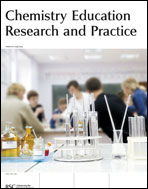A lesson plan on ‘methods of separating matter’ based on the Learning Company Approach – A motivating frame for self- regulated and open lab-work in introductory secondary chemistry lessons
Abstract
This paper describes the use of the learning company approach to lead classroom practice to more cooperative learning and a different style of experimentation. The lesson plan seeks to motivate the students in a cooperative mode to do their experiments self-regulated and self-organised. The approach, originally developed for a lesson plan on acids and bases for 10th grade chemistry lessons (age range 15-16), has been extended to the development of another lesson plan for younger students (6th or 7th grade, age range 11-13) following the same approach on the topic ‘Methods of Separating Matter’. The lesson plan and its development by Participatory Action Research are described. Data from teachers’ and students’ feedback is discussed. The discussion shows how the discourse from educational theory on a different style of experimentation can be put into practice. The evaluation confirms that open experimentation in a cooperative mode can be successfully applied by the learning company approach with such young students, leading to an open and attractive learning environment. [Chem. Educ. Res. Pract., 2007, 8 (2), 108-119]
- This article is part of the themed collection: The Laboratory in Science Education: The State of the Art

 Please wait while we load your content...
Please wait while we load your content...